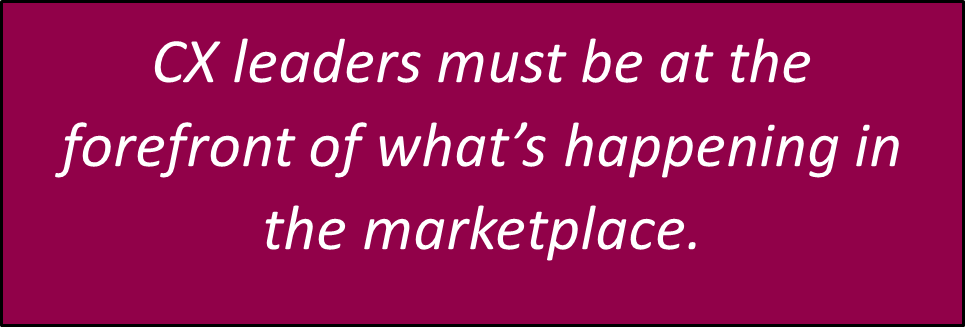Leading a customer-experience (CX) transformation requires a new mindset and a new way of operating. As a CX leader, you face the challenge of driving change across every function in the organization. You also have an opportunity to impact meaningful change as a thought leader who intersects with all the different functions within the business from the beginning to the end of experience management.
CX transformation requires more than comprehensive road maps and the implementation of business-as-usual programs to execute the needed change. CX has evolved into more innovation and change management because the marketplace has demanded it. The COVID-19 global pandemic not only changed consumer behavior and expectations but also pushed the accelerator for organizations to implement plans slated to happen years down the line.
With change occurring at an unprecedented pace, CX leaders must excel at organizational navigation, change resilience, and leadership.
Adopt a mindset of continuous learning
It’s well known that the most effective leaders are the most insatiable learners. CX leaders must stay in-tune with how consumers are changing and understand the impact on all areas of the business to be able to translate experience management into functional areas of the organization.

To do this, CX leaders need to adopt a continuous learning mindset and the ability to adapt and speak the customer’s language across all stages of the customer journey.
A continuous learning mindset supports the day-to-day work and collaboration required to advance CX transformation. The breadth and depth of knowledge also allows CX leaders and their teams to serve as thought leaders because they engage and collaborate across all functions in the organization.
Speak to the value CX delivers
Democratizing CX — making CX accessible to every function in the organization — requires education and a cultural shift in how the company operates as an organizational team.

It is about helping cross-functional stakeholders understand their role in CX and the value customer experience improvement delivers in whatever part of that customer lifecycle they have a role in or impact. CX leaders that speak to the value CX brings to the organization have more success influencing change across the organization.
As the CX leader, you must demonstrate how the work required for CX transformation improves all stakeholder outcomes. In practice, this means connecting outcomes, such as an improved NPS, with what that improvement means for the business. It’s about communicating the value of what CX has given back to the organization, whether it’s retention, increased loyalty, or customer lifetime value.
Build relationships within the organization
CX leaders are well-versed in the science and complexity behind experience management. The most successful leaders also understand CX transformation must be built on relationships within the organization.

Relationships with leaders across the organization’s functions, from the C-suite down, are strengthened when you lead with outcomes and communicate the value of CX — what’s in it for them.
CX leaders recruiting talent for their leadership team should look for those with the strongest relationships and who navigate the organization the best. CX expertise is not necessarily a requirement for your team of change agents — those skills and practices can be learned. Your team’s ability to build relationships and communicate the value of CX is what will drive CX transformation success.
Prioritize diversity for forward thinking

Historically CX teams had a high concentration of traditional marketing or research practitioners and backgrounds. As CX evolved, team members with operations, digital, and design backgrounds were sought after and recruited.
The advantages of diversity expand well beyond the CX team and lead to greater creativity and innovation across the organization. CX is not a siloed function; it is an organizational team role where every leader influences how the organization meets and exceeds customer expectations. CX leaders who embrace a mindset of continuous learning, lead the value CX delivers, build relationships, and prioritize diversity are the best positioned for success in leading CX transformations.
Democratize CX

A CX team plays two critical roles – democratizing CX and experience management. As the experience management organization, the goal is to democratize CX because you are the team that architects it. To be successful every function has a part in it, and everyone has a role to play.
Foster cross-departmental collaboration and ensure people understand their role. Be inclusive from the start, so that they can impact change in whatever part of the customer lifecycle they have a role in.
In summary
The nature of CX is continuous change; you and your team are the change agents for CX transformation. As change agents you must:
- Foster strong relationships across the organization.
- Lead conversations with outcomes to show them what’s in it for them and the organization.
- Be very thoughtful about change management.
Customer experience excellence requires a commitment to culture change. Here at ImprintCX, we understand the keys to successful CX programs and can support you along the way. Let’s get started.